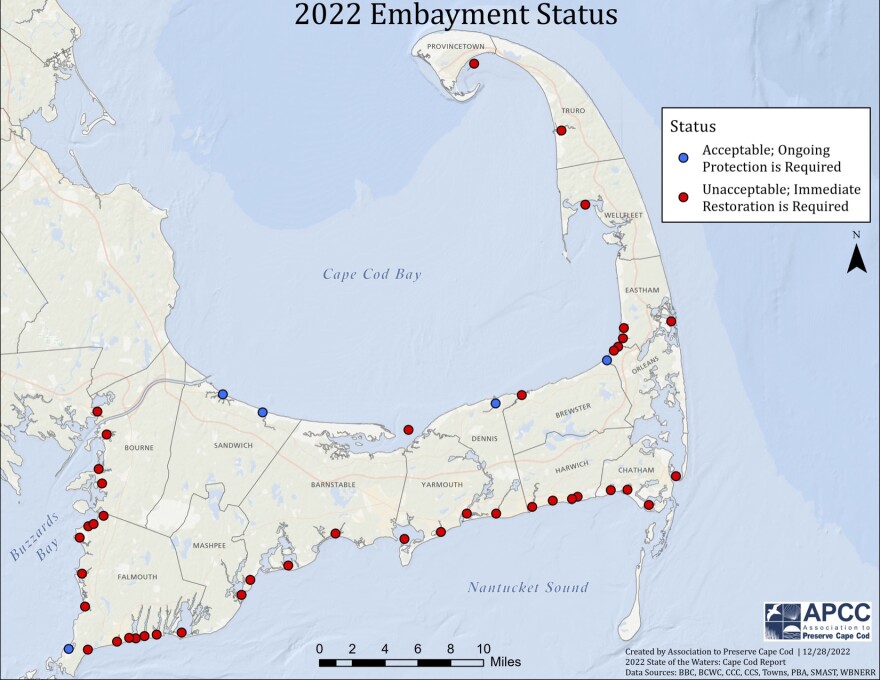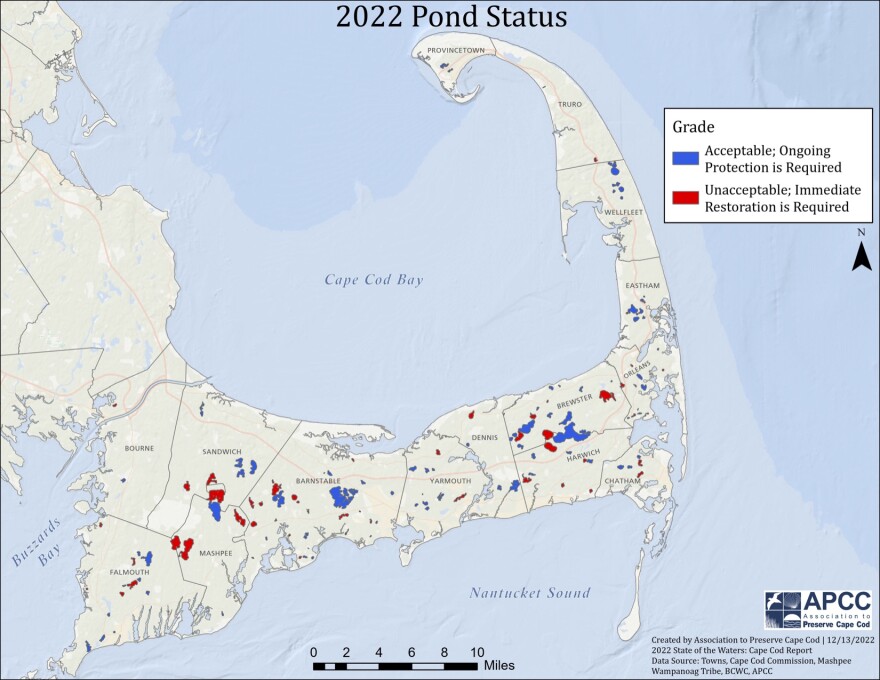Water quality has declined on the Cape — again. That’s according to the fourth annual State of the Waters report from the Association to Preserve Cape Cod (APCC). It looks at ponds, estuaries, embayments, and drinking water. To fully unpack it all, CAI’s Eve Zuckoff talked with APCC’s executive director Andrew Gottlieb on the shores of Santuit Pond in Mashpee.
Eve Zuckoff: Describe where we are, if you would.
Andrew Gottlieb: Well, we're standing here at Santuit Pond, and in the summer it's green. We've got a heavily developed shoreline, lawns that go down to the pond's edge, septic systems within a stone's throw of the pond, agricultural uses. So all the sources of phosphorus and nitrogen and excess nutrients that are feeding declining water quality are all evident on the shoreline to Santuit pond.
Eve Zuckoff: Okay, so that's Santuit Pond. But what did you find about the overall health of ponds across the Cape when you looked at nutrient pollution and the toxic algae growth, those cyanobacteria blooms we've heard about?
Andrew Gottlieb: Well, fairly consistently, about a third of the ponds that we evaluate have an unacceptable water quality aspect to it. What we did find in particular with the cyanobacteria blooms this year, they tended to be more significant. So higher concentrations of cyanobacteria, the associated toxicity that comes with those and they had a tendency to last a little bit longer this summer as opposed to prior.
The cape has a total of 890 freshwater ponds. Of the 151 ponds with sufficient water quality data and/or cyanobacteria data in 2021 to enable APCC's grading, there were 59 Unacceptable ponds, representing 39% of all graded ponds. In 2020, there were 38 Unacceptable ponds, representing 35% of graded ponds. In 2019, there were 39 Unacceptable ponds representing 42% of all graded ponds.
Eve Zuckoff: Are there areas in particular where the ponds were worse off?
Andrew Gottlieb: No. You know, one of the confounding things about the cyanobacteria is that it's fairly widely distributed across the Cape from National Seashore Ponds and Wellfleet, all the way to more heavily developed ponds like we're standing near in Mashpee. So I think the factors that are driving it are significant increases of temperature that have coincided with additional nutrient loading from more people, more development, and people being around their homes for longer parts of the year, given the effects of the pandemic and some of the population shifts we've seen.
Eve Zuckoff: So we've talked about ponds. What about the estuaries or embayments?
Andrew Gottlieb: So the estuaries have gotten worse. This is the fourth year that we've done this report. In the first year, 68 percent of our estuaries had unacceptable water quality. This year it's 90 percent. Of that 90 percent, there's not a single south-facing estuary on Cape Cod that doesn't have unacceptable water quality. And only one west-facing embayment—facing Buzzards Bay—has acceptable water quality. We're almost to the point where there are no more estuaries with good water quality to go bad.

Eve Zuckoff: Okay, those are the waterbodies where we work and play. How about the water we drink?
Andrew Gottlieb: As with all of our prior reports, we've generally found, with a few glaring exceptions, that water provided to public water supply customers on Cape Cod is really quite good. That said, two received poor scores this year. One was Otis National Guard water supply. They had a boil water order because of a bacterial contamination that raised a public health threat to them, and that's an automatic fail for our system. And the town of Yarmouth both had a bacterial problem and a PFAS violation in their finished water, which distinguishes them from the other ten public water suppliers who had PFAS in the water, who only had it in the source water but not in the finished water.

Eve Zuckoff: PFAS, meaning the so-called “forever chemicals” that can cause cancer and liver disease and all kinds of things as they accumulate in our bodies over time.
Andrew Gottlieb: Yeah, the fact is that there are low levels of PFAS fairly ubiquitously across the Cape in our groundwater, and therefore it shows up in drinking water supply wells and private wells, which we don't really have any good sense of at this point.
A total of 20 public water supplies were graded for the quality of their “finished water,” meaning water that has not yet gone through pipes and plumbing to come out the tap, but has been processed for customer distribution by a town’s public water system. Sixteen public water supplies on the Cape had “Excellent” water quality, meaning that they met all state and federal drinking water standards. However, of the 16 public water suppliers with “Excellent” grades, 10 had detectable levels of PFAS6 but met the new state standard for PFAS6 that became effective in 2021.
Eve Zuckoff: What are the long term impacts of all of this degraded water quality? What will we see on Cape Cod?
Andrew Gottlieb: Well, the water is the economy of Cape Cod, and the understood assumption is that the waters of the Cape warrant that kind of attention and investment. And to date they have, and, hopefully, we can get back to that. But I think we jeopardize everything that the economy of Cape Cod is built on. And by that, I mean everybody's individual property values, everybody's business investment, the ability to pass on wealth through property inheritance from one generation to the next to your children, your grandchildren—all of that is jeopardized by a continued decline in water quality. And it makes it all the more important that we actually do the things we know how to do already to solve some of these problems that we're seeing.
Eve Zuckoff: So what are those solutions?
Andrew Gottlieb: We know we can't continue to rely on septic systems that pollute our environment. We know that we can't continue to have fertilizer of lawns leaching directly into storm drains or the waterways that we say we're concerned about. And we have to control stormwater. Three things that will solve most of the growth level problems that we're seeing and the problems that aren't solved by those three control measures, we can figure out how to deal with that last five, ten, fifteen percent of the problem.
Eve Zuckoff: That’s Andrew Gottlieb, executive director of the Association to Preserve Cape Cod. Thank you.
Andrew Gottlieb: Thank you.
Find out more about the "State of the Waters" report and explore an interactive map.








